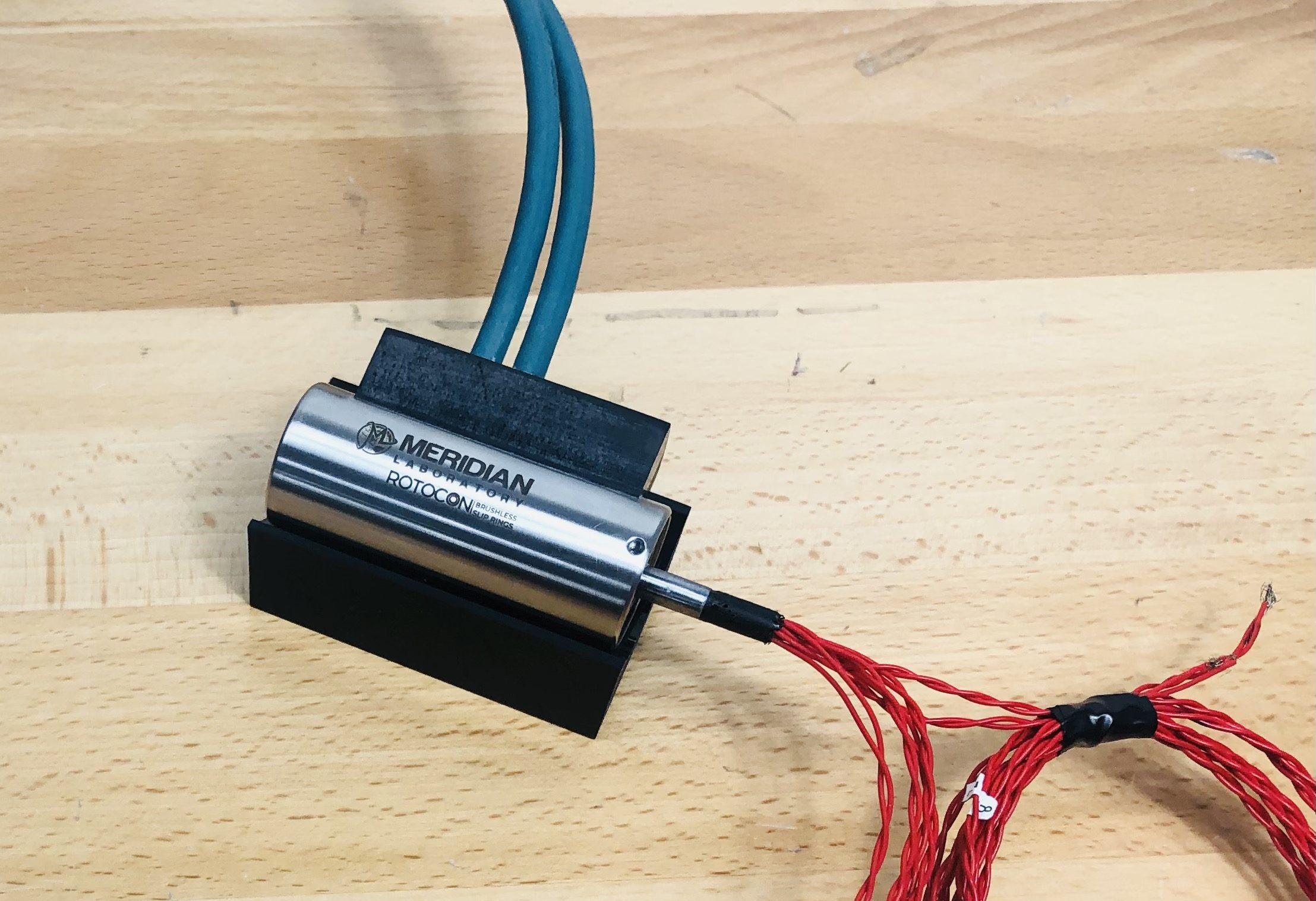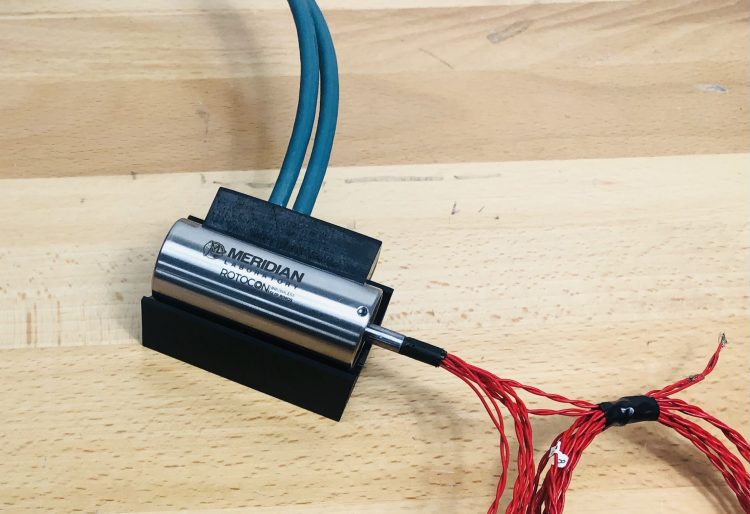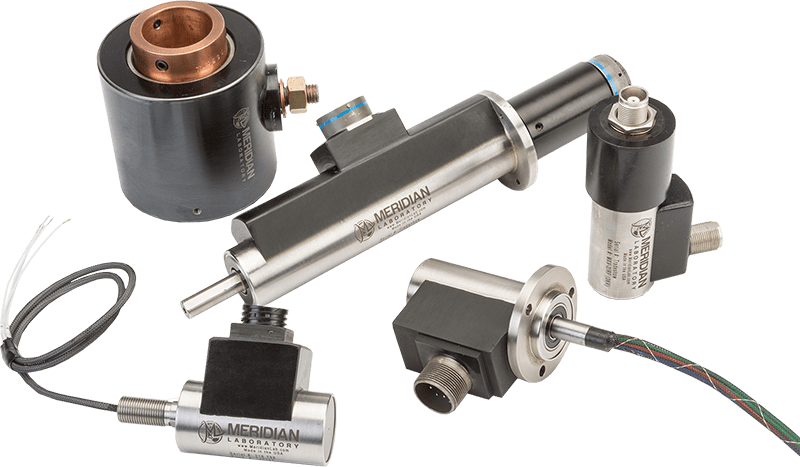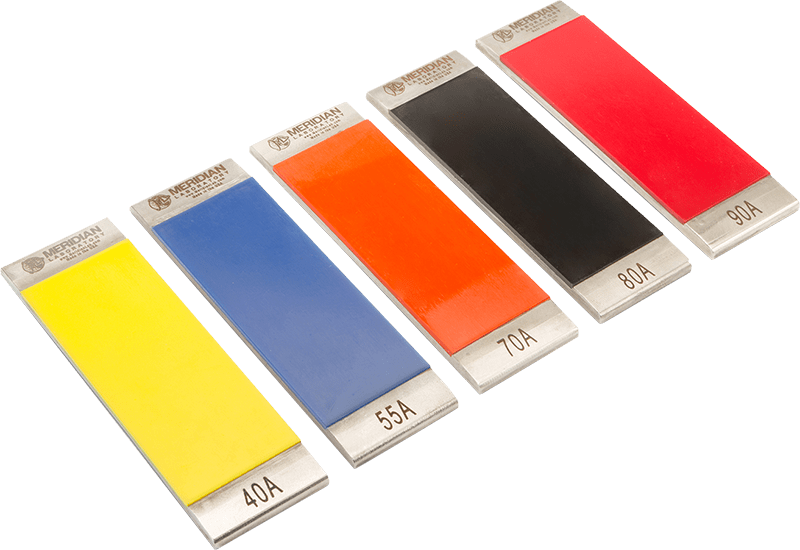Blog / 2022.01.13
Bit Error Rate (BER) in Ethernet Slip Rings

ROTOCONs Provide Consistent Power and Data Communication
This video tests Bit Error Rate (BER) in slip rings and demonstrates the facts about Ethernet & data transmission when using rotating Ethernet devices.
(Many slip ring manufacturers advertise a low BER, or even zero Bit Errors, but this is simply not factual. When it comes to Ethernet slip rings, ROTOCONs deliver results that others can only falsely claim.)
Meridian Laboratory tests every single ROTOCON Ethernet slip ring, and ensures that the Bit Error Rate is below 1E-10
A traditional brushed slip ring relies on a stationary graphite or metal contact (brush) which scrapes on the outside diameter of a rotating metal ring. This type of device leads to many Bit Errors. These Bit Errors are the result of poor signal quality, and data being lost forever, potentially causing issues in an application.
Unlike conventional slip rings, every ROTOCON features a brushless oil-sealed viscous wetted contact, providing an unrivaled 360 degrees of connection. ROTOCONs routinely deliver zero Bit Errors. The signal exiting a ROTOCON is as clear as the signal that went in. There are no detectable Bit Errors or packets lost.
Benefits provided by ROTOCON brushless slip ring:
• Perfect Signal & Power All in One Package Without Affecting the Quality of the Ethernet Communication
• Consistent Power and Data Communication (Gigabit Ethernet)
Meridian Laboratory tests every single ROTOCON Ethernet slip ring, and ensures that the Bit Error Rate is below 1E-10. Contact us today to learn more!

Test Results and Additional Information On BER
About Bits
Bits in their simplest sense are information. We can think of this information as a switch, our switch has two states, on and off, or a 1 and 0. This base 2 numbering system works just like the base ten system that we use, but by using less numbers. In this binary number system, we can think of the number 4 as being represented by the binary number 100. Now that we have a numbering system we can store any number, or numbers that correspond to letters or other data.
| Base 10 Number | 8s place | 4s place | 2s place | 1s place | Places added together | Final Binary Number |
| 1 | 0 | 0 | 0 | 1 | 0+0+0+1=1 | 0001 |
| 7 | 0 | 1 | 1 | 1 | 0+4+2+1=7 | 0111 |
| 14 | 1 | 1 | 1 | 0 | 8+4+2+0=14 | 1110 |
All computer systems run on this binary system. They even communicate with each other via this method, through communication protocols such as Ethernet, Profinet, RS232 and many other protocols that aren’t listed here.
Bit Errors & What They Are
When transmitting data, the majority is transmitted in bits. Frequently, it is transferred via Ethernet or similar communication protocols. These Ethernet systems have 2 or 4 pairs of twisted wires that they use to transmit this data. A Bit Error is when there is an error in the transmission of data, expressed as the compliment of the bit. For example, if you had been expecting a 1, you would have received a 0.
The Causes of Bit Errors
Bit Errors can be caused by many things, crosstalk between signal wires, poor terminations on the cabling, and a noisy signal. Noise can be caused by many things. One of them being a changing resistance. Traditional slip rings have a constantly changing resistance due to the inferior contacts. Traditional slip rings rely on a brush or wire that slides on a conductive ring. There are microscopic imperfections on these rings and wires that change the amount of contact resistance from the rotor to the stator of the device. On the other hand, high performance, brushless ROTOCON slip rings have a molecularly bonded liquid metal that makes a perfect contact between the rotating and stationary sides of the device. This contact surface minimizes the change in resistance so much that it performs like the slip ring is not even there. (If you would like to learn more about this, please reference the contact resistance white paper). In a traditional slip ring this ever changing resistance introduces noise into our system. Each signal has a specified amount of noise that can be introduced before bit errors start occurring, and in cases like Ethernet, a 1000 Mbps (gigabit) systems have a lower allowable noise than a 100 Mbps systems.
The Bit Error Rate & How it is Calculated
In order to test for the BER (Bit Error Rate), we must more accurately define what the Bit Error Rate is. The Bit Error Rate is the ratio of incorrect bits, to the total number of bits transferred. Now that we know how to determine the Bit Error Rate, it is quite simple to measure. First, on the sending end, a known pattern is generated that will be sent through our cabling. When this data is received, the pattern is analyzed to look for any inconsistencies from what was sent through the system. These inconsistencies are then logged and a running total for the amount of Bits Sent and Bit Errors are used for the calculation of the Bit Error Rate.
Effects of the Bit Error Rate on a System
When Bit Errors are introduced into a system, problems begin to occur. When we have a Bit Error, the entire packet of data that it was a part of must be retransmitted. This retransmission comes at a cost. Each re-transmission takes time, slows down data speed, and increases system latency. In the most extreme of cases, when the Bit Error Rate is high, there is a complete breakdown of the data transmission protocol. This can result in downtime in production or a complete shutdown of machinery.
In order to understand the effects that Bit Errors have on a system, more must be known about the data being sent. We can think of data transmission in computers as if it were someone sending Morse code. The only difference being, instead of dots, dashes and breaks, we have only 2 states, dot or break. In order to simplify things, we send chunks of data. Each chunk is a known length, and the first part of this chunk tells us what kind of data is to follow. This makes transmitting the data much easier if there is an error, because then instead of assuming all the data from the transmission session are bad, we only need to throw out one chunk of data and then send it again. This re-transmission of the data comes at a price. For every chunk that we throw out, our data speed slows down. In order to achieve the maximum data rate for your system, the Bit Error Rate must be as low as possible. For voice and low data speed systems, this might not be an issue, but when transmitting signals like video, audio, and other high-speed signals there may be significant data loss.
How Bit Error Rate Differs Between Traditional Slip Rings and ROTOCONs
Traditional slip rings are inherently noisy devices, noisy signals are one of the main causes of Bit Errors. These slip rings rely on metal or carbon brushes riding on a metal ring. As the slip ring is spun for more revolutions, more of the brush and the ring that it is riding on wear away. This wearing produces a fine carbon or metal dust that coats the inside of the device. After time the brushes will need to be replaced and the inside of the device cleaned of the dust. If the dust is not cleaned out, it can be a path that the signal leads begin having a connection to each other. Many slip ring manufacturers advertise that they are capable of 1 Gbps Ethernet speeds, but not all slip rings are able to deliver the necessary results. While these slip rings may perform at gigabit speeds while stationary, not all of these can maintain these speeds under rotation, especially as the rotational speed increases. Their changing resistance, and inferior build quality can cause bits to be dropped during rotation. A contactless viscous wetted slip ring can exceed expectations where a brushed slip ring will fail. A brushless ROTOCON slip ring is manufactured in such a way that the contact resistance between the rotor and the stator is minimized and constant. This low and consistent resistance performs more similarly to a wire than a slip ring.
Many common brushed slip rings that are mass produced produce extremely noisy signals. In testing competitor slip rings, we found some of the “Gigabit capable” slip rings to have a Bit Error Rate as high as 1E-6*. This correlates to an error every million bits. Meridian Laboratory tests every single Ethernet unit, and ensures that the Bit Error Rate is below 1E-10. This correlates to the maximum of one error for every ten billion bits that pass through the slip ring. For every 10,000 errors that the conventional slip ring has, a ROTOCON will likely not error at all.
LOOKING FOR MORE?
If you would like to discuss BER, slip rings, or if you have a project – contact us, our engineers are always open for new and exciting challenges.

